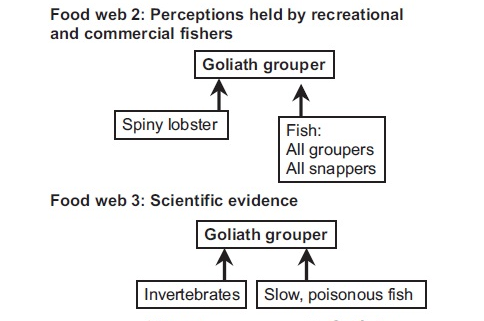Should Florida allow Goliath grouper to be culled?
by Becca Shelton, RJD Intern
Goliath grouper, Epinephelus itajara, were documented as commercially extinct in the late 1980’s and have had protection from fishing in USA waters since 1990. They are the largest grouper in the Atlantic Ocean, growing up to the record size of 2.5 m in total length and 450 kg, making them popular to fish. Like many other top-predators, Goliath grouper are very susceptible to being overfished because they are long-lived, slow growing, late to sexually maturity, need spawning aggregations to reproduce and are also very habitat/site specific. While they are still listed as critically endangered on the IUCN Red List throughout its range, tropical and subtropical Atlantic, recent studies suggest that juvenile stocks are recovering and adults are returning to spawning grounds in Florida. This is extremely exciting news to scientists and divers but local fisherman are calling for a cull (selective fishing) of Goliath grouper in Florida to protect commercial/recreational stocks of spiny lobster (Panulirus argus), grey snapper (Lutjanus griseus) and other species of grouper (Serranidae). In the paper, “Should the Critically Endangered Goliath grouper Epinephelus itajara be culled in Florida,” Dr. Sarah Frias-Torres looks at both the pros and cons to this argument.
Dr. Sarah Frias-Torres first examined the scientific evidence for and against culling and compared it to the negative social perception of Goliath grouper populations with spiny lobster, grey snappers and groupers (Figure 1). Using scientific data from isotope analyses, dentition and stomach content studies, Dr. Frias-Torres determined that Goliath grouper not only have a large variety of prey but also eat some of the marine organisms that consume spiny lobster. Contrary to the fisherman’s perception of the Goliath grouper’s diet, the recovery of Goliath grouper will cause top-down control and increase spiny lobster stocks by reducing mid-level predators. During the Goliath grouper commercial extinction from 1970-1990, spiny lobster and grey snapper populations did not increase, confirming that Goliath grouper are not directly impacting these populations.
So what is the actual cause of the decline in spiny lobster and grey snapper populations?

Figure 1. Fisherman’s perspective of Goliath grouper diet and perceived impact on commercial/recreational stock vs. scientific evidence of actual diet and impact.
The answer is Overfishing. Dr. Frias-Torres compared total catch by year and the total number of trips by year and discovered that there was a significant, negative correlation for both spiny lobsters and grey snapper (Figure 2). Over time, fishing pressure has increased and technology has made modern day fisherman so efficient that overfishing is inevitable without strict regulations. And even if legislation is passed to cull Goliath grouper, fisherman would also have to cull 26 different species that prey on spiny lobsters in order to increase the lobster population.

Figure 2. The significant, negative trends in the commercial fishing effort for spiny lobster (left) and grey snapper (right).
Should the Goliath grouper be culled in Florida? The presented evidence verifies that Goliath groupers are not the cause of spiny lobster and grey snapper population declines. They also provide top-down control to help alleviate predation pressure on spiny lobster by eating their predators. Other positive points in favor of not culling Goliath grouper include increased ecotourism as a diver attraction and the potential to provide biocontrol against increasing populations of invasive Indo-Pacific red lionfish (Pterois volitans/Pterois miles). Lionfish are voracious predators that prey on juvenile reef fish and invertebrates and are additional stressors on already struggling coral reef communities. The Goliath grouper’s diet also includes a decent amount of venomous fish, making Goliath grouper a perfect candidate for a potential lionfish predator. In conclusion, Florida should continue to protect recovering Goliath grouper populations for ecological and economical reasons and look into other methods to reduce fishing pressure on declining spiny lobster and grey snapper populations.
REFERENCES
Sarah Frias-Torres. Should the Critically Endangered Goliath grouper Epinephelus itajara be culled in Florida?. Oryx, Available on CJO doi:10.1017/S0030605312000361




Fishermen will say whatever they can to deny the reality that their practices are doing harm. Here in Hawaii they claim anything to shift the blame away from themselves.
The ecosystem was once balanced.. Culling would be irrelevant if we added further controls to balance the entire ecosystem. Call it crazy but the ocean managed to regulate itself for millions of years before us.
Interesting essay regarding my recent paper. Just an update. During the cold weather events of 2009 and 2010 about 90-95 % of the juvenile goliath grouper population in the Florida mangrove nurseries died. This is the loss of 8 year classes. We don’t expect any new recruitment to the adult population until 2018. This situation is a major step backwards in the slow recovery of the population.